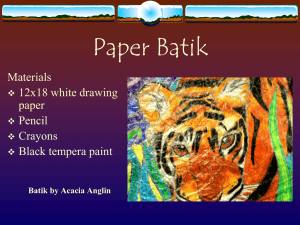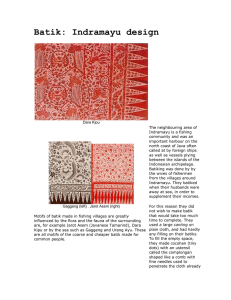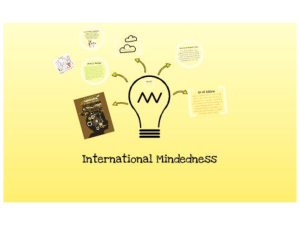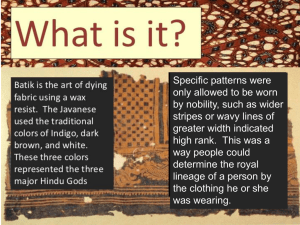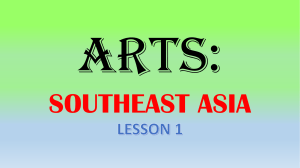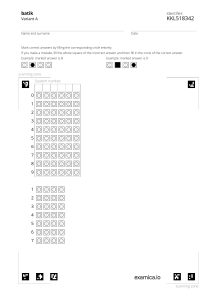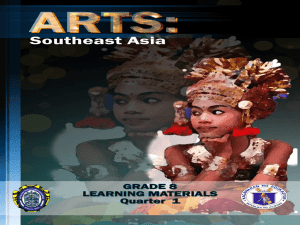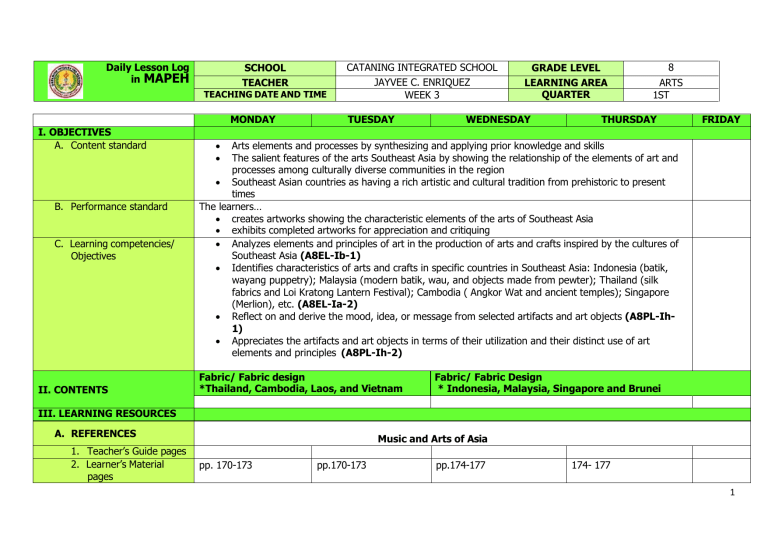
Daily Lesson Log in MAPEH SCHOOL TEACHER TEACHING DATE AND TIME MONDAY I. OBJECTIVES A. Content standard B. Performance standard C. Learning competencies/ Objectives II. CONTENTS CATANING INTEGRATED SCHOOL JAYVEE C. ENRIQUEZ WEEK 3 TUESDAY GRADE LEVEL LEARNING AREA QUARTER WEDNESDAY 8 ARTS 1ST THURSDAY FRIDAY Arts elements and processes by synthesizing and applying prior knowledge and skills The salient features of the arts Southeast Asia by showing the relationship of the elements of art and processes among culturally diverse communities in the region Southeast Asian countries as having a rich artistic and cultural tradition from prehistoric to present times The learners… creates artworks showing the characteristic elements of the arts of Southeast Asia exhibits completed artworks for appreciation and critiquing Analyzes elements and principles of art in the production of arts and crafts inspired by the cultures of Southeast Asia (A8EL-Ib-1) Identifies characteristics of arts and crafts in specific countries in Southeast Asia: Indonesia (batik, wayang puppetry); Malaysia (modern batik, wau, and objects made from pewter); Thailand (silk fabrics and Loi Kratong Lantern Festival); Cambodia ( Angkor Wat and ancient temples); Singapore (Merlion), etc. (A8EL-Ia-2) Reflect on and derive the mood, idea, or message from selected artifacts and art objects (A8PL-Ih1) Appreciates the artifacts and art objects in terms of their utilization and their distinct use of art elements and principles (A8PL-Ih-2) Fabric/ Fabric design *Thailand, Cambodia, Laos, and Vietnam Fabric/ Fabric Design * Indonesia, Malaysia, Singapore and Brunei III. LEARNING RESOURCES A. REFERENCES 1. Teacher’s Guide pages 2. Learner’s Material pages Music and Arts of Asia pp. 170-173 pp.170-173 pp.174-177 174- 177 1 3. Textbook pages 4. Additional Materials from Learning Resource (LR) portal B. OTHER LEARNING REFERENCES IV. PROCEDURES A. Reviewing Previous Lesson or Presenting New Lessons https://youtu.be/ZSfvs-sm5h0 https://youtu.be/5n9NOPWcWFUn https://youtu.be/1ylJzLnZ-XM WORLD MAP presentation: Ask the students to point out the different Southeast Asian Countries on the Map. Possible answer: Cambodia, Thailand, Laos, Vietnam, Indonesia, Malaysia, Singapore, and Brunei. 5 minutes B. Establishing A Purpose For The Lesson Let the students answer the question: What is fabric? Picture Showing: https://youtu.be/7ud6Hgv3odQ https://youtu.be/eUEt5C8vDl4 The teacher will ask these questions: What are the characteristics of silk fabrics? What are the two types of Cambodian weaving? 5 minutes What are the popular Vietnamese fabrics? Answers: Shantung taffeta Bengaline weave Ebony satin What are the symbols usually used by the Laos in their Sihns costumes? Answer: Crabs, snakes, butterfies, and birds. What are the two categories of batik design? What is the difference between hand-painted batik to Block printed batik? 5 minutes 5 minutes Picture analysis: The teacher will flash different kinds of motifs/designs of “BATIK“ fabrics 2 Using powerpoint presentation, the teacher will flash the different kinds of fabrics. Let the students observe the pictures. C. Presenting Examples / Instances of the New Lesson 25 minutes The teacher will ask the following questions: What are the elements being used in designing fabrics? Give examples of different fabrics in Southeast Asian countries. D. Discussing New Concepts and Practicing New Skills #1 10 minutes The teacher will discuss the following: Silk fabric (thai) Silk weaving in Cambodia Types of Cambodian Weaving (PowerPoint presentation) 10 minutes The student will ask these questions: What is a Batik? Describe the techniques being used in batik Making What are the elements and characteristics of Batik? 15 minutes Discussion on the following: Categories of batik designs Two types of batik produced https://youtu.be/7u d6Hgv3odQ https://youtu.be/5n 9NOPWcWFU https://youtu.be/eU Et5C8vDl4 30 minutes 3 20 minutes E. Discussing New Concepts and Practicing New Skills #2 The teacher will discuss the following: Cambodian textiles particularly the natural dyes. Significance of cotton textiles in Cambodia Lao weaving tradition Vietnamese fabrics o Shantung taffeta o Bengaline weave o Ebony satin https://youtu.be/ZSfvssm5h0 The teacher will discuss the following: A. Differentiate: Malaysian batik Indonesian Batik Singaporean Batik B. Brunei traditional textile C. Four different ways of batik. 10 minutes https://youtu.be/1ylJzLn Z-XM 25 minutes F. Developing Mastery (Leads To Formative Assessment 3) Activity Using the elements and principles of design, the students will create an example of Laos women’s Sihn using indigenous materials such as, paper, magazines, sacks, plastics, old clothes etc. Picture identification whether it is Malaysian Batik Indonesian Batik Singaporean Batik (10 pictures will be presented to the class) 4 The students’ output will be graded based on the rubric provided pp.198 20 minutes G. Finding Practical Applications of the Concepts And Skills In Daily Living Ask the students: As a grade 8 student, how can you help in the preservation in this kind of art? 10 minutes 1.What is the aesthetic value of Batik making in our daily lives? Cite examples of fabric design that is similar to Philippine fabrics. H. Making Generalizations and Abstractions About the Lesson I. Evaluating Learning 5 minutes What is the significance of fabric design in Philippine arts today? Quiz Identify the following: 1. It is to create patterns, weavers tie and dye portions of weft yarn before weaving begins. Ans: ikat technique 2. The Lao women’s traditional anklelongskirt is called . 2 minutes How batik making affects the development of once culture? What can you say about the Southeast Asian fabric design? How indigenous people established small business enterprises and produced traditional products to generate supplementary income to support their livelihood? 5 Ans: Sihn 5 minutes 3. It yields with single or two-color fabrics. Ans: Uneven twill 4. An all-natural lustrous silk hand-woven in southern Vietnam and naturally dyed using ebony fruit pods. Ans: Ebony satin 5. Weaving patterns in Vietnam containing centuries old symbols and characters. Ans: Old jacquard looms 5 minutes Activity: “Batik Making” J. Additional Activities for Application and Remediation K. Assignment Rubric: pp. 198 Make your own design of Sihn using different elements and principle of design. Bring the following materials: Old white shirt Acrylic paint Washable white glue Paint brushes 30 minutes Research on the following: Loy kratong Wayang kulit Wau kite songkok 6 Plastic placemate/wrap V. REMARKS VI.REFLECTION A. No. of Learners Who Earned 80% In The Evaluation B. No. of Learners Who Require Additional For Remediation Who Scored Below 80% C. Did The Remedial Lessons Work? No. of Learners Who Have Caught Up With The Lesson. D. No. of Learners Who Continue To Require Remediation E. Which of My Strategies Worked Well? Why Did These Work? F. What Difficulties Did I Encounter Which My Principal Or Supervisor Helped Me Solved? G. What Innovation or Localized Materials Did I Use / Discover Which I Wish To Share With Other Teachers? Prepared By: Checked By: Noted By: Jayvee C. Enriquez Teacher II Benjamin Joseph Lomibao Mater Teacher I Lisa G. Austria Principal IV 7
